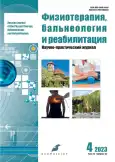The combination of electrotherapy with pelvic floor muscle training in the treatment of a patient with postcovid erectile dysfunction. Clinical case
- Authors: Al-Zamil M.K.1,2,3, Zalozhnev D.M.2, Kulikova N.G.1,4, Vasilieva E.S.5,6
-
Affiliations:
- Peoples’ Friendship University of Russia
- Medical Dental Institute
- Brain and Spine Clinic “Olivia”
- National Medical Research Center of Rehabilitation and Balneology
- Petrovsky National Research Centre of Surgery
- Russian University of Medicine
- Issue: Vol 22, No 4 (2023)
- Pages: 307-314
- Section: Clinical notes and case reports
- Published: 15.12.2023
- URL: https://rjpbr.com/1681-3456/article/view/595877
- DOI: https://doi.org/10.17816/rjpbr595877
- ID: 595877
Cite item
Abstract
Demyelinating inflammation of the pudendal nerve associated with COVID-19 has been clinically identified in many cases and has been proven in animal experiments. Many authors associate the development of erectile dysfunction after suffering COVID-19 with endothelial disorders in the urethra and other endocrine and psychological disorders.
In clinical practice, after the start of the COVID-19 pandemic, we have identified many cases of erectile dysfunction with confirmed neurophysiological and clinical disorders of the pudendal nerve. Despite active medical treatment, not all patients improve. In this regard, we decided to demonstrate this clinical case. The patient underwent a course of pelvic floor muscle training and transcutaneous electrical neurostimulation after the lack of effect of pharmacotherapy.
The diagnosis of erectile dysfunction against the background of damage to the pudendal nerve as a result of a history of COVID-19 was established on the basis of the patient’s complaints, anamnesis, clinical picture, biochemical, neuroimaging and neurophysiological methods of research. Before treatment, the pain syndrome was 7/10 points, the strength of the pelvic floor muscles was 2/5 points, the erectile function according to the erectile function index was 8/30 points and the quality of life as a result of erectile dysfunction was 46/60 points. The use of transcutaneous electrical nerve stimulation of the pudendal nerve in combination with training of the pelvic floor muscles proved to be very effective in the treatment of patients with severe pudendal neuralgia accompanied by severe erectile dysfunction, weakness of the pelvic floor muscles and impaired urination. Against the background of debilitation, the pain syndrome regressed by 78%, erectile dysfunction decreased by 2 times, the quality of life improved by 82.6% and the strength of the pelvic floor muscles increased by 75% and urination disorders completely regressed.
Full Text
About the authors
Mustafa Kh. Al-Zamil
Peoples’ Friendship University of Russia; Medical Dental Institute; Brain and Spine Clinic “Olivia”
Author for correspondence.
Email: alzamil@mail.ru
ORCID iD: 0000-0002-3643-982X
SPIN-code: 3434-9150
MD, Dr. Sci. (Med.), Professor
Russian Federation, Moscow; Moscow; PodolskDenis M. Zalozhnev
Medical Dental Institute
Email: olivia4967@mail.ru
ORCID iD: 0000-0001-8976-3378
Russian Federation, Moscow
Natalya G. Kulikova
Peoples’ Friendship University of Russia; National Medical Research Center of Rehabilitation and Balneology
Email: kulikovang777@mail.ru
ORCID iD: 0000-0002-6895-0681
SPIN-code: 1827-7880
MD, Dr. Sci. (Med.), Professor
Russian Federation, Moscow; MoscowEkaterina S. Vasilieva
Petrovsky National Research Centre of Surgery; Russian University of Medicine
Email: e_vasilieva@inbox.ru
ORCID iD: 0000-0003-3087-3067
SPIN-code: 5423-8408
MD, Dr. Sci. (Med.)
Russian Federation, Moscow; MoscowReferences
- Fenrich M, Mrdenovic S, Balog M, et al. SARS-CoV-2 dissemination through peripheral nerves explains multiple organ injury. Front Cell Neurosci. 2020;(14):229. doi: 10.3389/fncel.2020.00229
- Krasemann S, Haferkamp U, Pfefferle S, et al. The blood-brain barrier is dysregulated in COVID-19 and serves as a CNS entry route for SARS-CoV-2. Stem Cell Reports. 2022;17(2):307-320. doi: 10.1016/j.stemcr.2021.12.011
- Ni W, Yang X, Yang D, et al. Role of angiotensin-converting enzyme 2 (ACE2) in COVID-19. Crit Care. 2020;24(1):422. doi: 10.1186/s13054-020-03120-0
- Rodríguez-Morales J, Guartazaca-Guerrero S, Rizo-Téllez SA, et al. Blood-brain barrier damage is pivotal for SARS-CoV-2 infection to the central nervous system. Exp Neurobiol. 2022;31(4):270-276. doi: 10.5607/en21049
- Pennisi M, Lanza G, Falzone L, et al. SARS-CoV-2 and the nervous system: From clinical features to molecular mechanisms. Int J Mol Sci. 2020;21(15):5475. doi: 10.3390/ijms21155475
- Kinter KJ, Newton BW. Anatomy, abdomen and pelvis, pudendal nerve. 2022 Sep 12. In: StatPearls [Internet]. Treasure Island (FL): StatPearls Publishing; 2022.
- Pourfridoni M, Pajokh M, Seyedi F. Bladder and bowel incontinence in COVID-19. J Med Virol. 2021;93(5):2609-2610. doi: 10.1002/jmv.26849
- Adeyemi DH, Odetayo AF, Hamed MA, Akhigbe RE. Impact of COVID 19 on erectile function. Aging Male. 2022;25(1):202-216. doi: 10.1080/13685538.2022.2104833
- Chu KY, Nackeeran S, Horodyski L, et al. COVID-19 infection is associated with new onset erectile dysfunction: Insights from a national registry. Sex Med. 2022;10(1):100478. doi: 10.1016/j.esxm.2021.100478
- Mumm JN, Osterman A, Ruzicka M, et al. Urinary frequency as a possibly overlooked symptom in COVID-19 patients: Does SARS-CoV-2 cause viral cystitis? Eur Urol. 2020;78(4):624-628. doi: 10.1016/j.eururo.2020.05.013
- Welk B, Richard L, Braschi E, Averbeck MA. Is coronavirus disease 2019 associated with indicators of long-term bladder dysfunction? Neurourol Urodyn. 2021;40(5):1200-1206. doi: 10.1002/nau.24682
- Sansone A, Mollaioli D, Ciocca G, et al. Addressing male sexual and reproductive health in the wake of COVID-19 outbreak. J Endocrinol Invest. 2021;44(2):223-231. doi: 10.1007/s40618-020-01350-1
- Zhang J, Shi W, Zou M, et al. Prevalence and risk factors of erectile dysfunction in COVID-19 patients: A systematic review and meta-analysis. J Endocrinol Invest. 2023;46(4):795-804. doi: 10.1007/s40618-022-01945-w
Supplementary files











